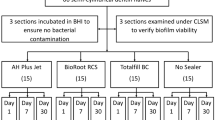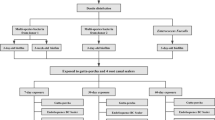Abstract
Objective
To investigate the antibacterial activity of calcium silicate–based sealers (CSBSs) against Enterococcus faecalis biofilm in a neutral or acidic condition.
Materials and methods
Dentin cylinders (4 mm length) were prepared and infected with 3-week-old E. faecalis. The samples were filled with BioRoot RCS (BR), EndoSequence BC (ES), and NeoMTA Plus (NMTA) and incubated in either neutral or acidic conditions for 7 days (n=10/group). Sterile or infected samples alone were used as the positive and negative control. The root canal sealers were removed after 7 days, and the remaining bacteria on dentinal walls were determined by colony-forming units (CFUs/ml), and three samples from each group were visualized under a confocal laser scanning microscope (CLSM). The pH was also measured (n=3/group) after 4 h and 7 days of incubation at 37°C in both conditions.
Results
In the neutral condition, all sealers significantly decreased the log-CFU values (p<0.05), while in the acidic condition, the log-CFU reduction was less for ES and NMTA, but a higher reduction was observed in BR (p<0.05). The antibacterial activity of CSBSs was similar in neutral conditions (p>0.05), and BR showed a greater antibacterial effect than ES and NMTA in the acidic condition (p<0.05). The pH of BR, ES, and NMTA ranged from 8.2 to 8.8 in the neutral condition in the presence of dentin after 7 days. However, acidic conditions reduced the pH values to 7.8 for BR, 6.0 for ES, and 5.8 for NMTA.
Conclusions
All CSBSs showed similar antibacterial activity in neutral conditions, while acidic pH had a reducing antibacterial effect on CSBSs.
Clinical relevance
Inflammatory pH decreased the antibacterial properties of CSBSs depending on the sealer type.


Similar content being viewed by others
References
Nair PN, Henry S, Cano V, Vera J (2005) Microbial status of apical root canal system of human mandibular first molars with primary apical periodontitis after “one-visit” endodontic treatment. Oral Surg Oral Med Oral Pathol Oral Radiol Endod 99:231–52. https://doi.org/10.1016/j.tripleo.2004.10.005
Zhang H, Shen Y, Ruse ND, Haapasalo M (2009) Antibacterial activity of endodontic sealers by modified direct contact test against Enterococcus faecalis. J Endod 35:1051–5. https://doi.org/10.1016/j.joen.2009.04.022
Silva Almeida LH, Moraes RR, Morgental RD, Pappen FG (2017) Are premixed calcium silicate-based endodontic sealers comparable to conventional materials? A systematic review of in vitro studies. J Endod 43:527–535. https://doi.org/10.1016/j.joen.2016.11.019
Alsubait S, Albader S, Alajlan N, Alkhunaini N, Niazy A, Almahdy A (2019) Comparison of the antibacterial activity of calcium silicate- and epoxy resin-based endodontic sealers against Enterococcus faecalis biofilms: a confocal laser-scanning microscopy analysis. Odontology 107:513–520. https://doi.org/10.1007/s10266-019-00425-7
Jeanneau C, Giraud T, Laurent P, About I (2019) BioRoot RCS extracts modulate the early mechanisms of periodontal inflammation and regeneration. J Endod 45:1016–1023. https://doi.org/10.1016/j.joen.2019.04.003
Siboni F, Taddei P, Prati C, Gandolfi M (2017) Properties of NeoMTA Plus and MTA Plus cements for endodontics. Int Endod J 50:e83–e94. https://doi.org/10.1111/iej.12787
Pinheiro LS, Iglesias JE, Boijink D, Mestieri LB, Poli Kopper PM, Figueiredo JAP, Grecca FS (2018) Cell viability and tissue reaction of NeoMTA Plus: an in vitro and in vivo study. J Endod 44:1140–1145. https://doi.org/10.1016/j.joen.2018.03.007
Siboni F, Taddei P, Prati C, Gandolfi MG (2017) Properties of NeoMTA Plus and MTA Plus cements for endodontics. Int Endod J 50(Suppl 2):e83–e94. https://doi.org/10.1111/iej.12787
Taha NA, Al-Khatib H (2022) 4-year follow-up of full pulpotomy in symptomatic mature permanent teeth with carious pulp exposure using a stainproof calcium silicate-based material. J Endod 48:87–95. https://doi.org/10.1016/j.joen.2021.09.008
De-Deus G, Canabarro A (2017) Strength of recommendation for single-visit root canal treatment: grading the body of the evidence using a patient-centred approach. Int Endod J 50:251–259. https://doi.org/10.1111/iej.12621
Paredes-Vieyra J, Enriquez FJJ (2012) Success rate of single- versus two-visit root canal treatment of teeth with apical periodontitis: a randomized controlled trial. J Endod 38:1164–1169. https://doi.org/10.1016/j.joen.2012.05.021
Su Y, Wang C, Ye L (2011) Healing rate and post-obturation pain of single- versus multiple-visit endodontic treatment for infected root canals: a systematic review. J Endod 37:125–132. https://doi.org/10.1016/j.joen.2010.09.005
Hojo S, Komatsu M, Okuda R, Takahashi N, Yamada T (1994) Acid profiles and pH of carious dentin in active and arrested lesions. J Dent Res 73:1853–7. https://doi.org/10.1177/00220345940730121001
Baras BH, Sun J, Melo MAS, Tay FR, Oates TW, Zhang K, Weir MD, Xu HHK (2019) Novel root canal sealer with dimethylaminohexadecyl methacrylate, nano-silver and nano-calcium phosphate to kill bacteria inside root dentin and increase dentin hardness. Dent Mater 35:1479–1489. https://doi.org/10.1016/j.dental.2019.07.014
Roy CO, Jeansonne BG, Gerrets TF (2001) Effect of an acid environment on leakage of root-end filling materials. J Endod 27:7–8. https://doi.org/10.1097/00004770-200101000-00002
Nassar M, Hiraishi N, Tamura Y, Otsuki M, Aoki K, Tagami J (2015) Phytic acid: an alternative root canal chelating agent. J Endod 41:242–247
Neelakantan P, Berger T, Primus C, Shemesh H, Wesselink PR (2019) Acidic and alkaline chemicals’ influence on a tricalcium silicate-based dental biomaterial. J Biomed Mater Res B Appl Biomater 107:377–387. https://doi.org/10.1002/jbm.b.34129
Ashofteh Yazdi K, Ghabraei S, Bolhari B, Kafili M, Meraji N, Nekoofar MH, Dummer PMH (2019) Microstructure and chemical analysis of four calcium silicate-based cements in different environmental conditions. Clin Oral Investig 23:43–52. https://doi.org/10.1007/s00784-018-2394-1
Elnaghy AM (2014) Influence of acidic environment on properties of biodentine and white mineral trioxide aggregate: a comparative study. J Endod 40:953–957. https://doi.org/10.1016/j.joen.2013.11.007
Wang Z, Ma J, Shen Y, Haapasalo M (2015) Acidic pH weakens the microhardness and microstructure of three tricalcium silicate materials. Int Endod J 48:323–332. https://doi.org/10.1111/iej.12318
Azim AA, Aksel H, Zhuang T, Mashtare T, Babu JP, Huang GT-J (2016) Efficacy of 4 irrigation protocols in killing bacteria colonized in dentinal tubules examined by a novel confocal laser scanning microscope analysis. J Endod 42:928–934. https://doi.org/10.1016/j.joen.2016.03.009
Bukhari S, Karabucak B (2019) The antimicrobial effect of bioceramic sealer on an 8-week matured Enterococcus faecalis biofilm attached to root canal dentinal surface. J Endod 45:1047–1052. https://doi.org/10.1016/j.joen.2019.04.004
Urban K, Neuhaus J, Donnermeyer D, Schäfer E, Dammaschke T (2018) Solubility and pH value of 3 different root canal sealers: a long-term investigation. J Endod 44:1736–1740. https://doi.org/10.1016/j.joen.2018.07.026
Wang Z, Shen Y, Haapasalo M (2014) Dentin extends the antibacterial effect of endodontic sealers against Enterococcus faecalis biofilms. J Endod 40:505–8. https://doi.org/10.1016/j.joen.2013.10.042
Stuart CH, Schwartz SA, Beeson TJ, Owatz CB (2006) Enterococcus faecalis: its role in root canal treatment failure and current concepts in retreatment. J Endod 32:93–8. https://doi.org/10.1016/j.joen.2005.10.049
Sedgley CM, Lee EH, Martin MJ, Flannagan SE (2008) Antibiotic resistance gene transfer between Streptococcus gordonii and Enterococcus faecalis in root canals of teeth ex vivo. J Endod 34:570–4. https://doi.org/10.1016/j.joen.2008.02.014
Bronzato JD, Davidian MES, de Castro M, de-Jesus-Soares A, Ferraz CCR, Almeida JFA, Marciano MA, Gomes B (2021) Bacteria and virulence factors in periapical lesions associated with teeth following primary and secondary root canal treatment. Int Endod J 54:660–671https://doi.org/10.1111/iej.13457
Kapralos V, Koutroulis A, Ørstavik D, Sunde PT, Rukke HV (2018) Antibacterial activity of endodontic sealers against planktonic bacteria and bacteria in biofilms. J Endod 44:149–154. https://doi.org/10.1016/j.joen.2017.08.023
Faria-Júnior NB, Tanomaru-Filho M, Berbert FL, Guerreiro-Tanomaru JM (2013) Antibiofilm activity, pH and solubility of endodontic sealers. Int Endod J 46:755–62. https://doi.org/10.1111/iej.12055
Candeiro GTM, Moura-Netto C, D’Almeida-Couto RS, Azambuja-Júnior N, Marques MM, Cai S, Gavini G (2016) Cytotoxicity, genotoxicity and antibacterial effectiveness of a bioceramic endodontic sealer. Int Endod J 49:858–864. https://doi.org/10.1111/iej.12523
Tian J, Zhang Y, Lai Z, Li M, Huang Y, Jiang H, Wei X (2017) Ion release, microstructural, and biological properties of iRoot BP Plus and ProRoot MTA exposed to an acidic environment. J Endod 43:163–168. https://doi.org/10.1016/j.joen.2016.10.011
Rodríguez-Lozano FJ, Collado-González M, López-García S, García-Bernal D, Moraleda JM, Lozano A, Forner L, Murcia L, Oñate-Sánchez RE (2019) Evaluation of changes in ion release and biological properties of NeoMTA-Plus and Endocem-MTA exposed to an acidic environment. Int Endod J 52:1196–1209. https://doi.org/10.1111/iej.13107
Barros J, Silva MG, Rôças IN, Gonçalves LS, Alves FF, Lopes MA, Pina-Vaz I, Siqueira JF Jr (2014) Antibiofilm effects of endodontic sealers containing quaternary ammonium polyethylenimine nanoparticles. J Endod 40:1167–71. https://doi.org/10.1016/j.joen.2013.12.021
Zhang W, Li Z, Peng B (2010) Ex vivo cytotoxicity of a new calcium silicate-based canal filling material. Int Endod J 43:769–74. https://doi.org/10.1111/j.1365-2591.2010.01733.x
Farhad A, Mohammadi Z (2005) Calcium hydroxide: a review. Int Dent J 55:293–301. https://doi.org/10.1111/j.1875-595x.2005.tb00326.x
Koutroulis A, Kuehne SA, Cooper PR, Camilleri J (2019) The role of calcium ion release on biocompatibility and antimicrobial properties of hydraulic cements. Sci Rep 9:19019. https://doi.org/10.1038/s41598-019-55288-3
Zehnder M, Waltimo T, Sener B, Soderling E (2006) Dentin enhances the effectiveness of bioactive glass S53P4 against a strain of Enterococcus faecalis. Oral Surg Oral Med Oral Pathol Oral Radiol Endod 101:530–5. https://doi.org/10.1016/j.tripleo.2005.03.014
Nerwich AH, Figdor D, Messer HH (1993) pH changes in root dentine following calcium hydroxide intracanal dressing. Aust Endod Newsl 19:30–31. https://doi.org/10.1111/j.1747-4477.1993.tb00393.x
Acknowledgements
The authors deny any conflicts of interest related to this study. CLSM images were taken at the University at Buffalo Optical Imaging and Analysis Facility, and we would like to thank Andrew McCall for his guidance during image processing.
Funding
This study was supported by the faculty funding from the University at Buffalo Foundation.
Author information
Authors and Affiliations
Corresponding authors
Ethics declarations
Ethics approval
This study is exempted for the ethical approval.
Consent to participate
The formal consent is not required due to the type of the study.
Conflict of interest
The authors declare no competing interests.
Additional information
Publisher's note
Springer Nature remains neutral with regard to jurisdictional claims in published maps and institutional affiliations.
Rights and permissions
About this article
Cite this article
Bosaid, F., Aksel, H. & Azim, A.A. Influence of acidic pH on antimicrobial activity of different calcium silicate based–endodontic sealers. Clin Oral Invest 26, 5369–5376 (2022). https://doi.org/10.1007/s00784-022-04504-y
Received:
Accepted:
Published:
Issue Date:
DOI: https://doi.org/10.1007/s00784-022-04504-y




